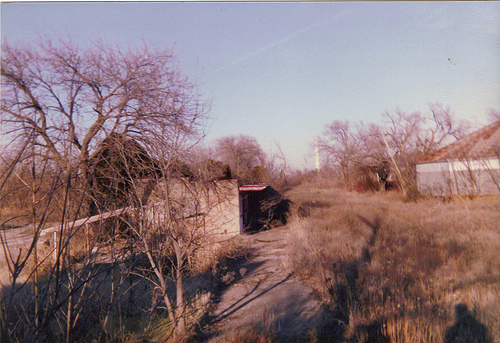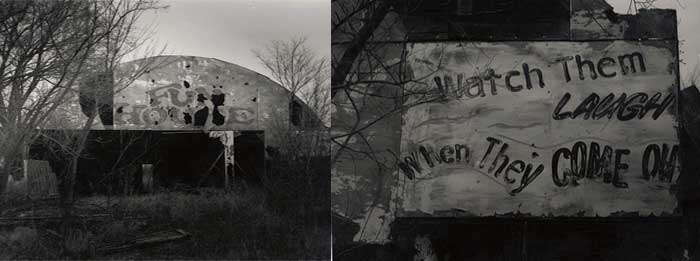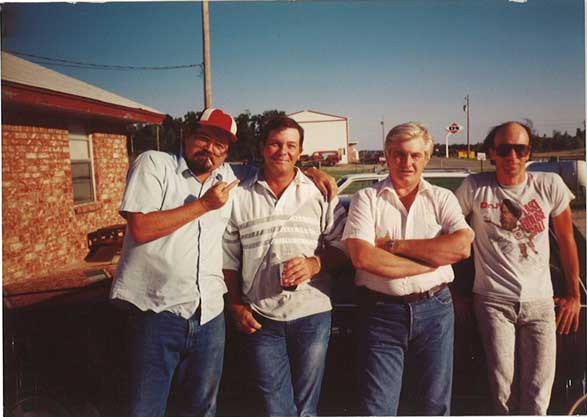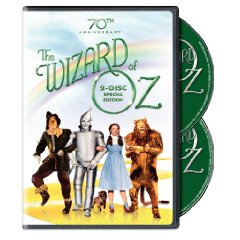Our field of dreams in 2002, no longer the unsullied vista we enjoyed as kids, though still largely undeveloped even at this time. But our dreams lay beyond the field, beyond the trees in the center of the photo, where once twinkled the lights of Lakeview Amusement Park, and the urgency of The Chiffons promising ‘One Fine Day.’ (Photo by David McGee)THE LIGHTS OF LAKEVIEW
By David McGee
"So Oz finally became home. The imagined world became the actual world, as it does for us all, because the truth is that once we have left our childhood places, and started out to make up our lives, armed only with what we have and are, we understand that the real secret of the ruby slippers is not that 'there's no place like home,' but rather that there is no longer any such place as home: except, of course, for the home we make, or the homes that are made for us, in Oz, which is anywhere, and everywhere, except the place from which we began."—The Wizard of Oz, Salman Rushie
Like many a Boomer, some part of my time here has been defined by The Wizard of Oz. I don’t know if I watched it when it first appeared on TV in 1956—probably so—but it became an annual ritual in our home, when my mother, father and (when he was in town—he lived and taught school out of state) my brother and I would convene in the living room to watch this delightful movie together. I remember my mother and father liking Judy Garland and, especially, Burt Lahr the best; my brother the intellectual and schoolteacher, the Wizard (“Do you know what ‘pusillanimous’means?” he always asked, which was quickly followed by “you ignoramus!” until the time I could recite the dictionary definition. He had spent way too much time in the Marines and in thrall of his drill instructors, a role he preferred to play in my company. I always suspected he asked me about pusillanimous because he didn’t know the meaning of caliginous, as in “You clinking, clattering collection of caliginous junk!”) Me? I was entranced by the whole spectacle, the characters, the dialogue, the great songs, the sheer outsized emotions in play, the sentimental ending—heck, I even loved the Fifth Estate’s one and only hit single, a 1967 rock ‘n’ roll version of “Ding! Dong! The Witch is Dead.”
Before I really knew why, I loved The Wizard of Oz with an intensity rivaled perhaps only by John Keats's love for his beloved Fannie Brawne. From a young age I knew writing was my calling, my passion, and I was mesmerized and electrified by the clever, smart use of language in Oz, in the songs and in the dialogue—I think I was hooked early on, when the Scarecrow tells Dorothy, “Some people without any brains do an awful lot of talking.” The Wizard’s penultimate speech to the four lost travelers seeking favors from him, as, one by one, he granted their wishes, so rich in high-minded rhetoric and that touching moment when he became less the benefactor and more a very human philosopher in reminding the Tin Man that “hearts will never be practical until they are made unbreakable,” and, placing a benevolent hand on him, “Remember my fine friend, a heart is judged not by how much you love, but by how much you are loved by others.”
The great Margaret Hamilton was always the talk at school because all of us believed she had to be close kin to the domineering, scabrous Mrs. Cormany, our merciless algebra teacher. (What a wicked old witch—picking on those of us who didn’t have a way with numbers and equations. Didn’t she know I wanted to be a writer anyway?) The Lollipop Guild munchkins could not have been more beloved for their spit-in-your-eye attitude and impish, squinting mugs. How many of us temporarily adopted Brooklyn accents and emulated Lahr’s great performance as the Cowardly Lion? “How long do you stay fresh in that can?” “Rhinoceros? I’d thrash him from top to bottomus!” “What makes the muskrat guard his musk, in the misty mist and the dusky dusk?” Numbers untold, my friends; numbers untold.
It was only much later—no doubt in the late ‘60s when the feminist moving was accelerating—that the dominance of the Oz women made an impression. I learned that L. Frank Baum, the book’s author, had feminist sympathies (he married Maug Gage, daughter of women's suffrage pioneer Matilda Joslyn Gage) that surface all through the story, as he empowers women every step of the way. Auntie Em clearly wears the pants in her family, and the truly wicked Almira Gulch is described by Em as owning “half the county.” The Wicked Witch of the West commands two formidable armies and a host of magical powers she uses to wail on her perceived enemies. Glinda, the Good Witch played by Billie Burke, protects and preserves Munchinland and its residents against the evildoers from the East and West. Even Dorothy, "the small and meek," calls the shots when she's traveling through Oz with her three male companions (and remember it was Dorothy who swatted the Cowardly Lilon on the nose when he was chasing Toto, leading to the revelation of the Lion's cowardice). All of which only deepened the allure of Oz and led to a closer examination of the original book, and an appreciation for its depth and imaginative vitality. (Other, more learned scholars than I have found unbelievable layers of meaning hidden in Baum’s plot and prose. Dig some of the other essays in this special section if you want an idea of the ongoing Oz-centered debates still flourishing lo these many years since the unofficial onset of Oz-ology in 1964.)
What really got me, though, was “Over the Rainbow.” What a beautiful performance by young Judy, her voice so wistful, so removed from her circumstance, so searching. Maybe it resonated deeply because when I stepped outside of my home on Tulsa’s north side—literally the other side of the tracks north of Hinderliter Heat Treating, beyond which lay something people south of the tracks feared. Poverty, perhaps, The black community, maybe. The whole otherness of the bleak north side.—it looked much like the flat, featureless Kansas of Dorothy Gale. Plus we knew tornadoes well—better than Kansans, I believe. Me and my childhood (now lifelong) buddies never really knew much about why our neighborhood was so threatenin, that is until Larry Clark’s book of photo essays titled Tulsa appeared in 1971. All the images were shot in our neighborhood in 1963, 1968 and 1971, and they documented wanton sex, rampant drug use (hoods shooting up speed, mostly) and generally self-destructive behavior—finally we had an answer to the question of why only two blocks away from our houses it was a no-man’s land, even by north Tulsa standards. Those were the guys Clark photographed, guys we never knew to go to school, and whose blocks we never rode our bikes on, because there was nothing but meanness over there.
I never harbored any grand ideas about getting out of Tulsa, felt no desperation to leave for brighter horizons. Despite Dorothy’s washed-out Kansas landscape being not all that dissimilar from and presumably less promising than Tulsa’s, I felt certain Tulsa was a bright enough horizon. Yet I have to admit to an inchoate longing I could never articulate or understand, only feel. I sensed it most profoundly on spring and summer nights, when, after dark, I, with my dearest, closest friend Mike, Gary, and sometimes Crazy Larry (when he wasn't at his most volatile during the years he was working on becoming the white Muhammad Ali, then Cassius Clay) in tow, would wander off to the sprawling, unmarred field about three blocks north of our houses. Nothing, absolutely nothing, was out there, only about 30 acres of pristine, undeveloped land. It wasn’t desolate to look at—it was all tall, waving grass, green in spring, bleached pale yellow in the unforgiving summer sun—but it was forbidding. It was the one open lot in the neighborhood that was totally unsuitable for any athletic endeavors. Too hilly for football, too rutted for baseball. It simply would not be adapted to any useful pursuit of our devising. Most of the time when we went to visit it, we stood outside a dilapidated barbed-wire fence that kept no one and nothing out. But we didn’t need to go beyond the fence to see what we came to see.
'Carney Row,' Lakeview Amusement Park (Tulsa, OK), early 1990's (Photo by Bryan Crain)
Off further north, about a mile and a half away, maybe, sat Lakeview Amusement Park. An incredible place where we spent many an hour when we could afford it. The batting cage was superb. The Tilt-a-Whirl was faster than the one at Bell’s Amusement Park on the south side. The old creaky carousel was the mellowest ride in town. At the carney booths lining the front of the park, the sales pitch was friendly and low key—I used to regularly win stuffed animals by shooting free throws at the Tulsa State Fair, but I never won anything playing the games at Lakeview. Most important of all was a Penny Arcade full of exotic wonders, such as the moviolas from the ‘40s that, for a penny, or a nickel, would play naughty films showing women in their underwear! Actually, they weren’t films—they were a series of flip cards that you viewed by turning a crank on the side of the viewer. There were other ancient machines that dispensed racy postcards from decades past. For a bunch of pre-teen, intensely curious boys with surging hormonal activity, there was no finer place to become educated in the world's great mysteries,, unless it was outside Dorothy Summers's (name changed to protect the innocent) bedroom window while she was changing clothes. The park even had a Fun House ride through what seemed like a cavernous structure on a darkened, serpentine track with spider webs caressing your forehead, a bus abruptly coming at you head on, horn blaring, and a cackling witch. Outside the Fun House was the real treat: a public address system playing a continuous loop of the “Okeh Laughing Record,” a recording from 1922 on which first a woman, then a man, then both, simply laugh hysterically for about three minutes. It was a huge hit in its day. Ruth Kager, a girl I dated one year in high school, eventually refused ever to go to Lakeview with me again, because “all you do is stand outside the scary house and laugh like a maniac.” As was her wont, Ruth was awash in hyperbole. In fact, I always made sure to spend some time in the batting cages when visiting Lakeview. I wasn't much of a boyfriend, but I by God could hit a curveball.
The Lakeview Fun House, early '90s (Photos by Bryan Crain)
But at night, Lakeview was transformed. From a distance. From outside the fence delineating the boundaries of the great, forbidding meadow—the Yellow Brick Road of our youth—as we stood silently in the dark of the Oklahoma night, a big sky stretching to infinity above us, we could see the twinkling lights of Lakeview, our Emerald City—lights on the ferris wheel, lights on the “scary house,” lights from the batting cages. They looked so much remote than they were, and to me they seemed a beacon marking another world, somewhere far beyond where we were, somewhere exciting and unknown. Somewhere, over the rainbow. None of us ever went to Lakeview at night, not even after we started driving. It was as if being under the lights of Lakeview would have been sacrilege. If you couldn’t figure out how to get beyond the lights of Lakeview, if you didn’t understand why you had to, don’t just go halfway. Never breach the barrier of the field without a purpose. We dreamed big dreams when studying those bright lights a world away from ours, we all understood them to symbolize more than what we knew we could all experience being on the park grounds. Do more, be more. As in Dead Poet’s Society, we didn’t read poetry; we let it drip from our tongues. Our minds ran free, and everything, everything was within reach.
Today, Gary has returned to Tulsa after hitting a rough patch, and is getting his life together. Crazy Larry, long the beneficiary of his father’s foresight, has not held a job since the Reagan era, but collects $60,000 a year from a tax-free trust dad left him, so he sits in his house all day, reading classic literature and watching pornography—one of the most articulate, learned men you will ever meet, who can discourse in depth on Jenna Jamesons’s oeuvre (and more). His wicked witch of a wife, who seems to regard Gary and I much as the apple trees did Dorothy and her friends—rude interlopers bent on purloining her precious fruit—has vowed to shoot us both if we ever show up at Gibson Manor again. Mike has been diagnosed with Alzheimer’s. I left Oklahoma in 1973, arriving in New York with my young bride in the fall of that year, and $20 left to our names. Here I am now on West 85th Street, having been published in Rolling Stone for the better part of 25 years, having written three books, having launched a growing online magazine, having raised two boys who know all about Lakeview, and the legendary exploits of David, Larry, Gary and Mike. (In fairness to Mike, I should add he always had more common sense than rest of us combined, so often was little more than spectator to our antics, which are better left unmentioned here. Or as Gary once observed, "Mike never could stand much weirdness.") I went over the rainbow, taking Oz with me, treasuring it more as the years go by. I've lived in New York City, and on West 85th Street, longer than I lived in Tulsa, and like hundreds of thousands, if not millions of others here, I regard it as home, as I do Tulsa, in fact, and I'm protective of both. I go back to Tulsa as often as the schedule and the finances allow, and the first nightfall finds me back on the north side, which is not the north side of my youth. The expansive meadow we used to haunt by night has given way to at least two businesses that have paved over its unsullied beauty. Lakeview was consigned to history decades ago, after standing as a creaking hulk of a ghost town for years. In the '70s the quaint carousel was sold to a motion picture company, and later native Tulsan Leon Russell bought everything else and shipped it out to California, where he was living. Generations have grown up never seeing the lights of Lakeview beckoning, never experiencing their talismanic lure, or sensing their promise of something greater beyond what the park, or even the city, could offer. Imagining them, in short, to be so much more than they really were
But I still see all of us out there, and they are always with me. I hear their laughter, I smell the fresh scent of a warm evening breeze like only Tulsa can offer, I can feel the battery acid sizzle in my throat of Coke frozen in real bottles, I hear the crack of baseball bats on the diamond at Celia Clinton Elementary School, where we played baseball on 100-degree-plus summer days, from the time we got out of bed until the sun went down, almost without a break and always with the company of a transistor radio tuned to rock 'n' roll on KAKC (it was out there that I first heard Dusty Springfield's voice, singing "Silver Threads and Golden Needles" with the Springfields. It stopped play.) Out there, where the Lakeview penny arcade once stood, I imagine I can still hear my nickels dropping into the jukebox and urgent, pounding piano chords erupting and the Chiffons promising “One Fine Day,” or Bobby Vee imploring, “Take Good Care of My Baby.” Life was grand in our Emerald City.
In his very sensible and acutely observed book length essay on The Wizard of Oz, author Salman Rushdie, noting how in Baum's final book of the Oz series Dorothy returns to Oz for good, taking Aunt Em and Uncle Charley along with her, leaving Kansas forever, marks our real home to be the one we construct for ourselves further on down the line, when we decide who we are going to be, and where we will plant ourselves. He's got a point, to be sure, but contrary to what Rushdie asserts at the end of his essay, I believe that despite the half-continent separating me from my childhood friends in Tulsa, I have learned the lesson in going over the rainbow that they may have known all along, and so stayed put. Simply stated...
There’s no place like home.
Home in Tulsa: (from left) 'Crazy' Larry (in a typical pose), Mike, Gary, David
***
A Grand New 'OZ'
Warner Home Video is celebrating the 70th anniversary of the film’s release with a wonderful new DVD and Blu-ray release. Mostly what casual fans will notice are colors more vivid than on the 1995 release, which in and of itself was pretty spectacular. This one retains many of the superb special features of that earlier release—such as the first-rate bios of the essential cast members, a documentary on the making of the film, home movies made on the set by composer Harold Arlen—and adds a documentary on director Victor Fleming (one of four Oz directors, but the one who got the title credit (he left before the movie was complete to start work on Gone With the Wind; King Vidor finished up, including shooting the Kansas scenes and Judy Garland’s “Over the Rainbow” performance); a 52-page book by Oz authority John Fricke; a delightful “sing-along” subtitle stream; and, for serious Oz scholars, two complete silent Oz features produced and directed by Baum himself during his failed effort to break into the movie business, The Magic Cloak of Oz and The Patchwork Girl of Oz. Purists are even given the option of selecting the original mono soundtrack over the stereo version. It is, as the saying goes, fun for kids and for the kid in you.
Buy it at www.amazon.com
Read the 1900 Edition of L. Frank Baum’s The Wonderful Wizard of Oz, complete with reproductions of the original illustrations, at
http://www.bygosh.com/wizardofoz/index.htm
Founder/Publisher/Editor: David McGee
Contributing Editors: Billy Altman, Laura Fissinger, Christopher Hill, Derk Richardson
Logo Design: John Mendelsohn (www.johnmendelsohn.com)
Website Design: Kieran McGee (www.kieranmcgee.com)
Staff Photographers: Audrey Harrod (Louisville, KY; www.flickr.com/audreyharrod), Alicia Zappier (New York)
E-mail: thebluegrassspecial@gmail.com
Mailing Address: David McGee, 201 W. 85 St.—5B, New York, NY 10024






